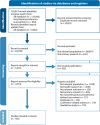Global evidence of gender equity in academic health research: a scoping review
- PMID: 36792322
- PMCID: PMC9933760
- DOI: 10.1136/bmjopen-2022-067771
Global evidence of gender equity in academic health research: a scoping review
Abstract
Objectives: To chart the global literature on gender equity in academic health research.
Design: Scoping review.
Participants: Quantitative studies were eligible if they examined gender equity within academic institutions including health researchers.
Primary and secondary outcome measures: Outcomes related to equity across gender and other social identities in academia: (1) faculty workforce: representation of all genders in university/faculty departments, academic rank or position and salary; (2) service: teaching obligations and administrative/non-teaching activities; (3) recruitment and hiring data: number of applicants by gender, interviews and new hires for various rank; (4) promotion: opportunities for promotion and time to progress through academic ranks; (5) academic leadership: type of leadership positions, opportunities for leadership promotion or training, opportunities to supervise/mentor and support for leadership bids; (6) scholarly output or productivity: number/type of publications and presentations, position of authorship, number/value of grants or awards and intellectual property ownership; (7) contextual factors of universities; (8) infrastructure; (9) knowledge and technology translation activities; (10) availability of maternity/paternity/parental/family leave; (11) collaboration activities/opportunities for collaboration; (12) qualitative considerations: perceptions around promotion, finances and support.
Results: Literature search yielded 94 798 citations; 4753 full-text articles were screened, and 562 studies were included. Most studies originated from North America (462/562, 82.2%). Few studies (27/562, 4.8%) reported race and fewer reported sex/gender (which were used interchangeably in most studies) other than male/female (11/562, 2.0%). Only one study provided data on religion. No other PROGRESS-PLUS variables were reported. A total of 2996 outcomes were reported, with most studies examining academic output (371/562, 66.0%).
Conclusions: Reviewed literature suggest a lack in analytic approaches that consider genders beyond the binary categories of man and woman, additional social identities (race, religion, social capital and disability) and an intersectionality lens examining the interconnection of multiple social identities in understanding discrimination and disadvantage. All of these are necessary to tailor strategies that promote gender equity.
Trial registration number: Open Science Framework: https://osf.io/8wk7e/.
Keywords: education & training (see medical education & training); general medicine (see internal medicine); health services administration & management.
© Author(s) (or their employer(s)) 2023. Re-use permitted under CC BY-NC. No commercial re-use. See rights and permissions. Published by BMJ.
Conflict of interest statement
Competing interests: None declared.
Figures
References
-
- CIHR . What is gender? what is sex? 2020. Available: https://cihr-irsc.gc.ca/e/48642.html
Publication types
MeSH terms
Grants and funding
LinkOut - more resources
Full Text Sources



